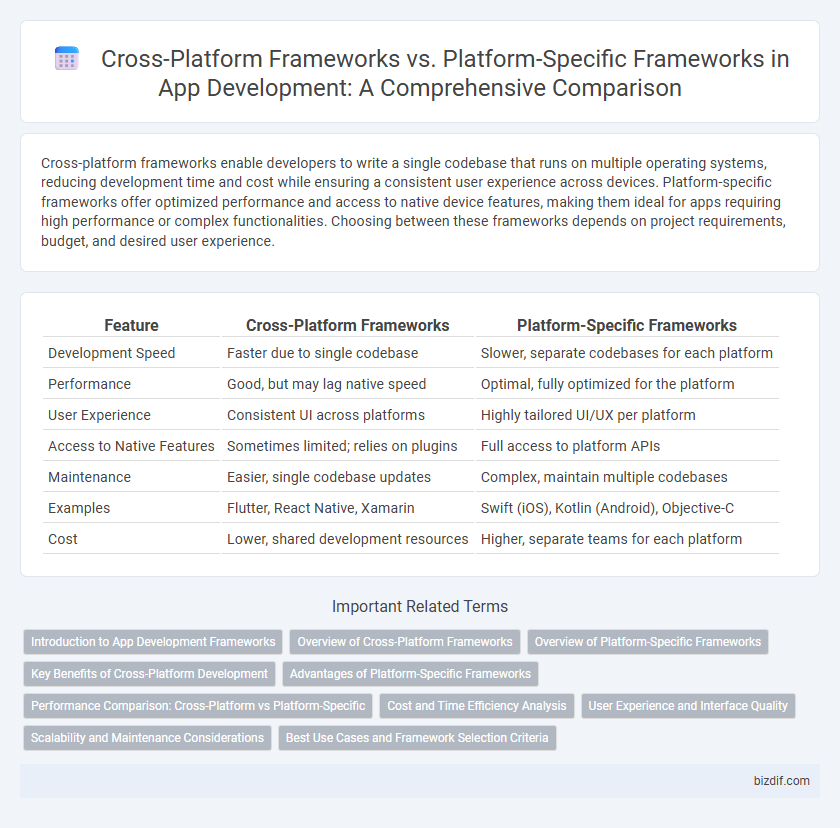Cross-platform frameworks enable developers to write a single codebase that runs on multiple operating systems, reducing development time and cost while ensuring a consistent user experience across devices. Platform-specific frameworks offer optimized performance and access to native device features, making them ideal for apps requiring high performance or complex functionalities. Choosing between these frameworks depends on project requirements, budget, and desired user experience.
Table of Comparison
| Feature | Cross-Platform Frameworks | Platform-Specific Frameworks |
|---|---|---|
| Development Speed | Faster due to single codebase | Slower, separate codebases for each platform |
| Performance | Good, but may lag native speed | Optimal, fully optimized for the platform |
| User Experience | Consistent UI across platforms | Highly tailored UI/UX per platform |
| Access to Native Features | Sometimes limited; relies on plugins | Full access to platform APIs |
| Maintenance | Easier, single codebase updates | Complex, maintain multiple codebases |
| Examples | Flutter, React Native, Xamarin | Swift (iOS), Kotlin (Android), Objective-C |
| Cost | Lower, shared development resources | Higher, separate teams for each platform |
Introduction to App Development Frameworks
Cross-platform frameworks like React Native and Flutter enable developers to write a single codebase that runs on both Android and iOS, reducing development time and costs. Platform-specific frameworks such as Swift for iOS and Kotlin for Android offer deeper integration with native features, resulting in optimized performance and user experience. Choosing the right framework depends on project requirements, including budget, timeline, and desired app functionality.
Overview of Cross-Platform Frameworks
Cross-platform frameworks enable developers to write a single codebase that runs efficiently on multiple operating systems such as iOS, Android, and Windows, significantly reducing development time and costs. Popular frameworks include React Native, Flutter, and Xamarin, each offering unique advantages like native performance, extensive libraries, and strong community support. These frameworks facilitate consistent UI/UX design across platforms while allowing access to native device features through plugins and APIs.
Overview of Platform-Specific Frameworks
Platform-specific frameworks enable developers to build applications tailored to a single operating system, such as Swift for iOS or Kotlin for Android, ensuring optimal performance and seamless integration with native APIs. These frameworks provide access to the latest device features and UI components, enabling a highly responsive and visually cohesive user experience. Development with platform-specific frameworks often results in faster execution speeds and better utilization of hardware capabilities compared to cross-platform alternatives.
Key Benefits of Cross-Platform Development
Cross-platform frameworks enable developers to write a single codebase that runs seamlessly on multiple operating systems such as iOS and Android, significantly reducing development time and costs. They provide consistent user experience and easier maintenance by allowing simultaneous updates across platforms. Access to a broader market with faster deployment cycles is a key benefit driving adoption of frameworks like React Native, Flutter, and Xamarin.
Advantages of Platform-Specific Frameworks
Platform-specific frameworks offer superior performance and enhanced access to device hardware, enabling developers to fully utilize native APIs for a seamless user experience. These frameworks provide better integration with platform-specific features and updates, ensuring faster adoption of the latest operating system capabilities. Tailored tooling and debugging support in platform-specific environments accelerate development cycles and improve app stability.
Performance Comparison: Cross-Platform vs Platform-Specific
Cross-platform frameworks like React Native and Flutter offer faster development cycles by enabling a single codebase across multiple platforms but may exhibit slightly lower performance due to abstraction layers. Platform-specific frameworks such as Swift for iOS and Kotlin for Android optimize hardware and OS-level capabilities, resulting in superior speed, responsiveness, and access to native APIs. Developers prioritize platform-specific frameworks for performance-critical applications requiring smooth animations, low latency, and advanced features unique to each operating system.
Cost and Time Efficiency Analysis
Cross-platform frameworks like React Native and Flutter significantly reduce development time and costs by enabling a single codebase for both iOS and Android, minimizing resource allocation. Platform-specific frameworks such as Swift for iOS and Kotlin for Android often result in higher expenses and prolonged timelines due to separate codebases and specialized expertise requirements. Businesses aiming for rapid market entry and lower budgets typically prefer cross-platform solutions for cost and time efficiency.
User Experience and Interface Quality
Cross-platform frameworks like Flutter and React Native enable developers to build apps with a single codebase, but may face limitations in delivering fully native user interfaces and performance optimizations. Platform-specific frameworks such as Swift for iOS and Kotlin for Android provide deeper access to native APIs, resulting in superior user experience and interface responsiveness tailored to each operating system. Prioritizing platform-specific development often leads to higher-quality animations, smoother interactions, and better adherence to design guidelines, enhancing overall app usability.
Scalability and Maintenance Considerations
Cross-platform frameworks such as React Native and Flutter offer scalability by enabling code reuse across multiple platforms, reducing development time and maintenance costs. Platform-specific frameworks like Swift for iOS and Kotlin for Android provide optimized performance and easier debugging but require separate codebases, which can increase maintenance complexity. Choosing the right approach depends on project scalability requirements and long-term maintenance resources.
Best Use Cases and Framework Selection Criteria
Cross-platform frameworks such as React Native and Flutter excel in projects requiring rapid development and consistent user experience across iOS and Android with a single codebase, ideal for startups and MVPs. Platform-specific frameworks like Swift for iOS and Kotlin for Android offer deep integration and superior performance, making them optimal for apps demanding high security, advanced native features, or complex UI designs. When selecting a framework, prioritize criteria including development speed, budget constraints, target audience, performance requirements, and long-term maintenance considerations to ensure alignment with business goals.
Cross-platform frameworks vs Platform-specific frameworks Infographic

 bizdif.com
bizdif.com